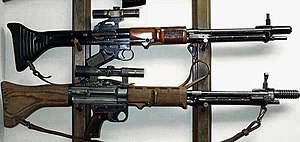| Fallschirmjägergewehr 42 | |
|---|---|
 Both early model (top) and late model (bottom) variants of the FG 42 with telescopic sights. | |
| Type | |
| Place of origin | Nazi Germany |
| Service history | |
| In service | 1943–1970s |
| Used by | See Users |
| Wars | |
| Production history | |
| Designer | Louis Stange |
| Designed | 1941–1942 |
| Manufacturer |
|
| Produced | 1943–1945 |
| No. built | ~7,000 |
| Variants |
|
| Specifications | |
| Mass |
|
| Length |
|
| Barrel length | 500 mm (19.7 in) |
| Cartridge | 7.92×57mm Mauser |
| Action | Gas-operated, rotating bolt |
| Rate of fire |
|
| Muzzle velocity | 740 m/s (2,428 ft/s) (SmK bullet) |
| Effective firing range | 600 m (1,968.5 ft) |
| Feed system | 10- or 20-round detachable box magazine |
| Sights |
|
The FG 42 (German: Fallschirmjägergewehr 42, "paratrooper rifle 42") is a selective-fire 7.92×57mm Mauser automatic rifle[4][5] produced in Nazi Germany during World War II.[7] The weapon was developed specifically for the use of the Fallschirmjäger airborne infantry in 1942 and was used in very limited numbers until the end of the war.
It combined the characteristics and firepower of a light machine gun in a lightweight form slightly shorter (but considerably bulkier and heavier) than the standard-issue Karabiner 98k bolt-action infantry rifle. Considered one of the most advanced weapon designs of World War II,[8][9] the FG 42 influenced post-war small arms development, and many features of its design, such as general shape, stock style, gas-rotating bolt operation (itself copied from the Lewis gun) and sheet metal and plastic construction were copied by the US Army when they developed the M60 machine gun.[10]
- ^ James, Frank W. (2014). "The Machine Gun Investor". In Lee, Jerry (ed.). Gun Digest 2015. F+W Media, Inc. p. 88. ISBN 978-1440239120.
- ^ Thompson, Leroy (2014). The M14 Battle Rifle. Bloomsbury Publishing. p. 8. ISBN 9781472802569.
- ^ McNab, Chris (2015). The World's Greatest Small Arms: An Illustrated History. Amber Books Ltd. p. 197. ISBN 9781782742746.
- ^ a b Hogg, Ian V.; Weeks, John (2000). Military Small Arms of the 20th Century (7th ed.). Krause Publications. pp. 241–242. ISBN 978-0-87341-824-9.
- ^ a b "New German Rifle for Paratroopers". Intelligence Bulletin. II (10). June 1944.
- ^ "WWII German weapons during the Vietnam War". WWII After WWII. 10 July 2015.
- ^ German Airforce (Luftwaffe) (September 1944). Fallschirmjagergewehr 42 Waffen-Handbuch D. (Luft) T.6194 [Paratrooperrifle 42 Weapons-manual D. (Luft) T.6194] (in German).
- ^ Senich, Peter (1987). The German Assault Rifle: 1935–1945. Paladin Press. p. 239.
- ^ Miller, David (2007). Fighting Men of World War II: Axis Forces : Uniforms, Equipment and Weapons. Stackpole Books. p. 104.
- ^ Bishop, Chris (2002). The Encyclopedia of Weapons of World War II. Sterling Publishing. p. 217.